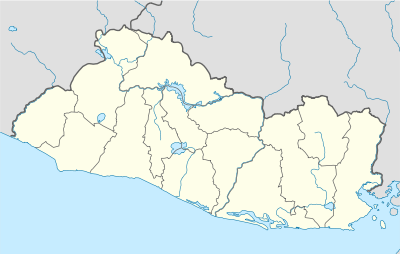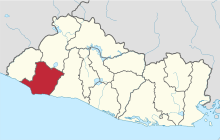Izalco
| Izalco | |
|---|---|
| Municipality | |
 Izalco | |
| Coordinates: 13°44′N 89°40′W / 13.733°N 89.667°WCoordinates: 13°44′N 89°40′W / 13.733°N 89.667°W | |
| Country | El Salvador |
| Department | Sonsonate |
| Municipality | Izalco |
Izalco (in Nawat: Itzalku)[1] is a municipality in the Sonsonate department of El Salvador. Volcan Izalco is an icon of the country of El Salvador, a very young Volcano on the flank of Santa Ana volcano. From when it was born in 1770 until 1966, it was in almost continuous eruption and was known as the "lighthouse of the Pacific." Since then it has been nearly inactive.
History
Peasant uprising in 1932
Izalco was a center of the 1932 Salvadoran peasant uprising. Its native Pipil peasants were led by Feliciano Ama, who was hanged by government troops on January 28. More than one fourth of the population of Izalco was killed.
Main sights
Church Dolores de Izalco
It is located in the city of Izalco, in the municipality and district of the same name, in the feet of the volcano of the same name, at 6.5 Kilometers to the northeast of the city of Sonsonate. It has an elevation of 440 meters over sea level.
It was built in year previous to 1570, because in this year the parish was very organized, according to the civil documents of Caluco. It is unknown who built it but its benefactor was Don Diego de Guzmán.
The church is surrounded by an atrium, the facade is of three bodies, but only two bodies of the church remain, the inferior and the middle one.
The inferior body has many accesses; one main and two laterals: The three accesses have the shape of an arch of half point. They have four couples of Tuscan columns and entablatures with classic decorations that divide the two bodies at the same time. In the middle body, there is an ocular and other four couples of columns. The molds or entablatures that divide the two bodies have fitomorphic decorations. The superior body or españada of recent construction is decorated with pilasters and gothic decorations in relief. In the superior part, there is a clock installed and is crowned by a small dome and a cross.
To each side of the españada, there are steeples that have the same decoration style, crowned also by a dome and a cross.
The lateral and later facades are reinforced with support columns. The walls are decorated with entablatures with classic decorations that divide the two bodies at the same time. In the middle body, there is an ocular and other four couples of columns. The molds or entablatures that divide the two bodies have fitomorphic decorations. The superior body or españada of recent construction is decorated with pilasters and gothic decorations in relief. In the superior part, there is a clock installed and is crowned by a small dome and a cross.
To each side of the españada, there are steeples that have the same decoration style, crowned also by a dome and a cross.
The lateral and later facades are reinforced with support columns. The walls are decorated with entablatures and the lateral accesses are framed with ionic columns. Another lateral access even preserves the decoration that is believed was the original one, with Baroque ornaments that look like a flower and leaves. You can observe that same decoration in a superior corner of the later facade.
The interior of the church possesses some original parts as the presbytery and the bases of the columns. The rest has been remodeled. The roof is made of tile and wood.
Church Of Asunción Of Izalco
The church is of Baroque style. The facade is of altarpiece type and it consists of two bodies. The inferior is decorated with two pairs of Tuscan columns on each side of the main access, which was built in an arch of half point and whose lateral sides look like Tuscan columns.
It has two ornamental ovals in relief, amid the couples of columns. The superior body is decorated with four pinnacles. It is framed with scrolls and crowned with a cross. A square oracle is located in the center, which provides illumination to the temple.
In the lateral sides of the church there is an access on each side and several support columns. The lateral walls are decorated with entablatures of classic style; the roof is of two wooden waters and iron sheets.
According to Monsignor Cortez y Laraz, the parish of Asunción was located in the Barrio de los indios, and by the year 1770, it didn’t have a parish priest. It was also destroyed by Santa Marta earthquake in 1773.
In 1580, the bell given by the Emperor Carlos I of Spain and V of Germany was consecrated.
People
- Maria Teresa Tula, political activist, was born here in 1951.[2]
Sports
The local professional football club is named C.D. Mario Calvo and it currently plays in the Salvadoran Third Division.
References
- ↑ The Nawat Language Recovery Initiative: IRIN
- ↑ Maria Reresa Tula, Dictionary of Women Worldwide, 2007, retrieved 7 April 2015
